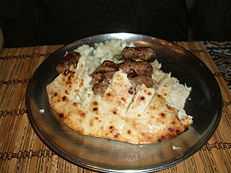Bosnia and Herzegovina cuisine
Bosnian cuisine is balanced between Western and Eastern influences. The food is closely related to Turkish, Middle Eastern, and other Mediterranean cuisines. However, due to years of Austrian rule, there are also many culinary influences from Central Europe.
Ingredients
Bosnian cuisine uses many spices, but usually in moderate quantities. Most dishes are light, as they are cooked in lots of water; the sauces are fully natural, consisting of little more than the natural juices of the vegetables in the dish. Typical ingredients include tomatoes, potatoes, onions, garlic, bell peppers, cucumbers, carrots, cabbage, mushrooms, spinach, courgette, dried and fresh beans, plums, milk, paprika and cream called pavlaka and kajmak. Typical meat dishes include primarily beef and lamb. Some local specialties are ćevapi, burek, dolma, sarma, pilav (pilaf), gulaš (goulash), ajvar and a whole range of Eastern sweets. The best local wines come from Herzegovina where the climate is suitable for growing grapes. Plum or apple rakija, is produced in Bosnia.
Meat dishes

Bosnian
Ćevapi with onions in a
somun
Bosnian rolled burek
- Ćevapi – Bosnian kebabs: small grilled meat sausages made of lamb and beef mix; served with onions, sour cream, ajvar and Bosnian pita bread (somun)
- Pljeskavica - a patty dish
- Begova Čorba (Bey's Stew) – a popular Bosnian soup (chorba) made of meat and vegetables
- Filovane paprike or punjena paprika – fried bell peppers stuffed with minced meat
- Sogan-dolma – onions stuffed with minced meat
- Popara – bread soaked in boiling milk or water and spread with kajmak
- Ćufte – meatballs
- Meat under sač (meso ispod sača) – a traditional way of cooking lamb, veal, or goat under a metal, ceramic, or earthenware lid on which hot coals and ashes are heaped
- Pilav (pilaf) - grain, such as rice or cracked wheat, browned in oil, and then cooked in a seasoned broth
- Burek – a meat-filled flaky pastry, traditionally rolled in a spiral and cut into sections for serving. The same dish filled with cottage cheese is called sirnica, one with spinach and cheese zeljanica, and one with potatoes krompiruša. All these varieties are generically referred to as pita (Bosnian for "pie").
- Sarma – meat and rice rolled in pickled cabbage leaves
- Grah – a traditional bean stew with meat
- Japrak – grape leaves stuffed with meat and rice
- Musaka – a baked dish made of layers of potatoes (or cabbage or egg plant)and minced beef
- Bosanski Lonac – Bosnian meat stew cooked over an open fire
- Tarhana - typical Bosnian soup with homemade pasta
- Sudžuk - (Sujuk) – spicy beef sausage
- Suho meso – air-dried meat similar to Italian bresaola
- Dolma - stuffed grape leaves with rice
Vegetable dishes
- Đuveč – vegetable stew, similar to the Romanian ghiveci, the Bulgarian gjuvec, and the Hungarian lecso
- Grašak – pea stew
- Kačamak – a traditional Bosnian dish made of cornmeal and potatoes
- Kljukuša – grated potatoes mixed with flour and water and baked in an oven; a traditional dish in the region of Bosanska Krajina
- Sataraš – a dish made with bell peppers, eggplants, onions and tomatoes
- Turšija – pickled vegetables
- Buranija - green bean stew
Cheeses
Desserts
- Baklava – flaky pastry with a filling of nuts, drenched in sugar syrup or honey
- Gurabija
- Halva
- Hurmašica – date-shaped pastry drenched in a sweet syrup
- Jabukovača – pastry made of filo dough stuffed with apples
- Kadaif
- Kompot – a cold sweet drink made of cooked fruit
- Krofna - filled doughnut
- Krempita
- Oblande
- Orasnica - walnut cookie
- Palačinka (crêpe)
- Pekmez
- Rahatluk – lokum (Turkish Delight)
- Ružica – similar to baklava, but baked in a small roll with raisins
- Ruske Kape (trans. Russian Caps, plural)
- Šampita - a whipped marshmallow-type dessert with fillo dough crust
- Slatko (made from different fruits)
- Sutlijaš (rice pudding)
- Tufahija – whole stewed apple stuffed with a walnut filling
- Tulumba - deep-fried dough sweetened with syrup
Relishes/Seasoning/Bread
Alcoholic beverages
Wines are produced mainly in Herzegovina, in the regions of Mostar, Čitluk, Ljubuški, Stolac, Domanovići, and Međugorje.
- Medovina
- Kruškovac
- Pelinkovac
- Rakija
- Blatina
- Žilavka
- Local spirits are distilled from plums, pears, or grapes, with alcohol content of 45% and higher.
- Šljivovica (plum brandy)
Non-alcoholic beverages
Kitchenware
External links
References
- Tim Clancy, Bosnia & Herzegovina, The Bradt Travel Guide, 2004, pp. 93–97, ISBN 1-84162-094-7
- Darra Goldstein; Kathrin Merkle, Fabio Parasecoli, Stephen Mennell, Council of Europe. Directorate General IV-Education, Culture and Heritage, Youth and Sport. Culinary cultures of Europe: identity, diversity and dialogue. Council of Europe. pp. 87–94 . ISBN 92-871-5744-8.
|
|---|
| | Northern Africa | |
|---|
| | Southern Europe | |
|---|
| | European regions | |
|---|
| | Western Asia | |
|---|
|



